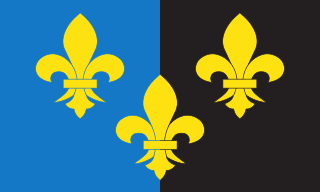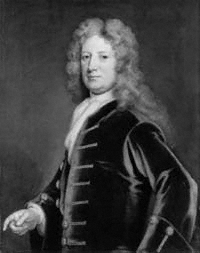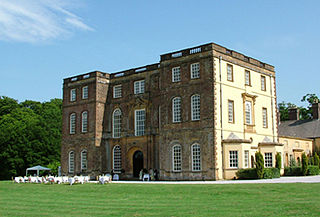Related Research Articles

Monmouthshire, also known as the County of Monmouth, is one of thirteen historic counties of Wales and a former administrative county. It corresponds approximately to the present principal areas of Monmouthshire, Blaenau Gwent, Newport and Torfaen, and those parts of Caerphilly and Cardiff east of the Rhymney River.

Baron Wharton is a title in the Peerage of England, originally granted by letters patent to the heirs male of the 1st Baron, which was forfeited in 1729 when the last male-line heir was declared an outlaw. The Barony was erroneously revived in 1916 by writ of summons, thanks to an 1844 decision in the House of Lords based on absence of documentation. As such, the current Barony of Wharton could more accurately be listed as a new Barony, created in 1916, with the precedence of the older Barony.

Cefn Mably House is a mansion situated in Cefn Mably, Caerphilly County Borough, Wales. It is a Grade II listed building.

Halswell House is a Grade I listed country house in Goathurst, Somerset, England.
This article is about the particular significance of the decade 1700–1709 to Wales and its people.
This article is about the particular significance of the year 1785 to Wales and its people.
Sir Trevor Williams, 1st Baronet of Llangibby, Monmouthshire, was a Welsh gentry landowner and politician who sat in the House of Commons at various times between 1660 and 1692. He played a significant part in events during and after the English Civil War in South Wales, siding first with King Charles, then with the Parliamentarians, before rejoining the Royalists in 1648.
Sir Charles Kemeys, 2nd Baronet was the second of the Kemeys Baronets, a Welsh family of landowners in the county of Monmouthshire, Wales.

Sir Nicholas Kemeys, 1st Baronet was a Welsh landowner and soldier during the English Civil War in South Wales and played a key part in events in the region during that conflict.
This article is about the particular significance of the year 1702 to Wales and its people.
This article is about the particular significance of the year 1735 to Wales and its people.
Events from the year 1754 in Wales.
The Kemeys Baronetcy, of Kevanmabley in the County of Glamorgan, was a title in the Baronetage of England. It was created on 13 May 1642 for the Welsh landowner and politician Nicholas Kemeys. His son, the second Baronet, was knighted before succeeding in the title and fought in the Civil War. The latter's son, the third Baronet, and grandson, the fourth Baronet, were both Members of Parliament. The title became extinct on the fourth Baronet's death in 1735.

Lieutenant-Colonel Sir Charles Gould Morgan, 2nd Baronet, was a Welsh soldier and politician, the MP for Brecon and County of Monmouth.
John Arnold, widely known as John Arnold of Monmouthshire, was a Welsh Protestant politician and Whig MP. He was one of the most prominent people in Monmouthshire in the late 17th century. A stark anti-Catholic, he was a notable figure during the Popish plot and the suppression of Catholicism in the country. Arnold represented the constituencies around Monmouth and Southwark in Parliament in the 1680s and 1690s. His strong anti-Catholic beliefs and insurgences against Catholic priests made him an unpopular and controversial figure amongst his peers and in his native Monmouthshire. In his later years his behaviour became increasingly eccentric, and he was widely believed to have faked an attempt on his own life. Amongst his associates were Titus Oates and Anthony Ashley Cooper, 1st Earl of Shaftesbury.
Sir Thomas Powell, 1st Baronet, of Broadway, Laugharne, Carmarthenshire and Coldbrook Park, Abergavenny, Monmouthshire, was a Welsh lawyer and politician.

Sir Charles Kemys Tynte, 5th Baronet, of Halswell House, near Bridgwater, Somerset and Cefn Mably, Glamorganshire, was a British politician who sat in the House of Commons between 1745 and 1774.
Sir Charles Kemeys, 4th Baronet (1688–1735) was a British Tory politician who sat in the House of Commons between 1713 and 1734.
This article is about the particular significance of the year 1705 to Wales and its people.
This article is about the particular significance of the year 1704 to Wales and its people.
References
- ↑ Griffith Milwyn Griffiths. "Kemeys and Kemeys-Tynte family, of Cefn Mabli, Monmouth". Dictionary of Welsh Biography . National Library of Wales . Retrieved 20 July 2019.
- ↑ William Retlaw Williams (1895). The Parliamentary History of the Principality of Wales, from the Earliest Times to the Present Day, 1541-1895. Priv. print. for the author by E. Davis and Bell.